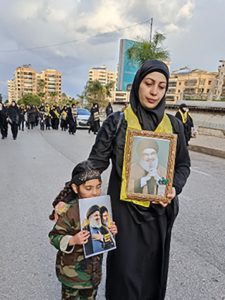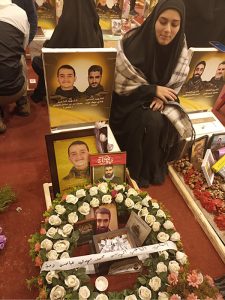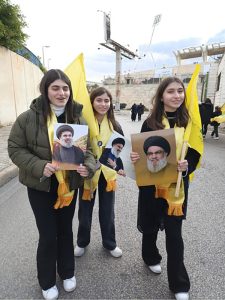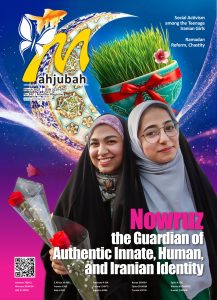What follows is a heartfelt note by Zohreh Yazdanpanah, a reporter and documentary maker who had recently paid a visit to Lebanon.
Lebanon again; but this time, on the eve of the funeral and burial of the dear leader of the resistance, Martyr Sayyid Hassan Nasrallah, and his longtime friend, Sayyid Hashem Safi al-Din. This comes in the aftermath of the Al-Aqsa Storm in Gaza and the heroic actions of Yahya Sinwar and Muhammad Deif, which marked the Israeli regime’s humiliation and forced acceptance of a ceasefire and prisoner exchange. It also signifies the epic period of the return of the people of southern Lebanon to their homes, their renewed resistance, and their stand against Israeli Merkava tanks in post-Sayyid Hassan Nasrallah Lebanon. This is further set against the backdrop of the downfall of Syria, where supportless Syrians – especially women and children – have lost their homes and sought refuge in parts of southern Lebanon.
In an era when, in some corners of this universe, individuals devoid of any sense of humanity show no concern for the struggles of others, and through their thoughts and actions, inflict harm and harassment on others, it truly makes me sick.
However, on this planet, there are also human beings who, in anonymity and humility, have chosen to stand by others and embody the spirit of Saadi’s poem—a poem so profound that it is inscribed on the wall of a meeting room in the United Nations:
“Human Beings are members of a whole
In creation of one essence and soul
If one member is inflicted with pain
Other members uneasy will remain
If you have no sympathy for human pain
The name of human you cannot pertain”
 Now, the question is: Which group and which ideology do we belong to? Where do each of us stand in this world, and what is our relationship with the people around us?
Now, the question is: Which group and which ideology do we belong to? Where do each of us stand in this world, and what is our relationship with the people around us?
In the universe, where the creation of man is certainly not and cannot be in vain, at this very sensitive moment in time, we may find ourselves standing where we should not be and not where we should be!
Travels increase experience and broaden the scope of thought, and if they are purposeful and combined with the search for truth, they must be seen, heard, and certainly narrated…
Perhaps, in addition to narrating the various developments in Islamic Iran, we should also include the narration of other significant issues, such as the progress of humanity and knowledge, fairness and chivalry, truth-seeking, freedom and justice, a sense of responsibility, honesty and integrity, gratitude, loyalty, and adherence to the covenant that God has taken from the souls—to worship none other than Him. This should also encompass the intellectual awareness and insight of some, as well as the regression seen in others, whether in Iran or different corners of the world. Such a narrative could serve as a balanced measure of standards, particularly in shaping the way of thinking regarding the concept of waiting and the reappearance of the Imam of the Time.
The oppressed people in different corners of the world await the reappearance of the promised savior; the innocent women and children of Gaza, the oppressed people of Palestine, Yemen, and Syria, the Lebanese veterans and bereaved people, and the Syrian refugees in Lebanon, etc.
 Me, the Hamra Hotel, and the Syrian Refugee Camp
Me, the Hamra Hotel, and the Syrian Refugee Camp
Easy access to the internet is a challenge here, limiting my ability to provide detailed narratives. As a result, I am compelled to keep my accounts brief.
Sayyid Mustafa said: “Hajji has asked me to take you to Hamra.” He then added with a smile: “The Hamra Hotel.” I understood the meaning of his smile when we arrived at one of the Syrian refugee camps in Beirut. The camp is housed in what used to be a university; a four-story building that, after being closed for fourteen years, has now been reopened to accommodate Syrian refugees. The responsibility for managing this camp lies with jihadist groups. Among them are young people who have even brought their wives and small children to contribute to the effort.
One of them is Sheikh Ibrahim. He had previously gone to Syria with his wife and two-year-old child to assist Lebanese refugees. His second child was born in Syria. After the fall of Syria, they were among the last to leave and return to Lebanon. Now, in this camp, he serves as one of the administrative officials, handling everything from electrical wiring to fixing room locks. I am currently staying in one of the rooms next to one of the active jihadist groups that have come to Lebanon to aid the refugees.
 Meeting with the Sister of Martyr Imad Mughniyeh
Meeting with the Sister of Martyr Imad Mughniyeh
We were informed of going to visit the sister of martyr Imad Mughniyeh, Nahida Khanum. I thought we would be guests at her house. When we arrived, we entered the Husseiniyeh, which was at the end of what looked like a parking lot to enter the building. The Husseiniya of Imam Hassan Mujtaba (AS), launching which had been the dream of a young man named Sadiq for years. Now the Husseiniya was underway and the young Haaj Sadiq was shedding tears for the loss of his martyred friends who once had a place in a corner of this Husseiniya. The last of them was Abu Turab. Haaj Sadiq had stories that are worth hearing and I had to go back to him.
We were informed that we would be visiting Nahida Khanum, the sister of the martyr Imad Mughniyeh. I assumed we would be guests at her home. However, upon arrival, we entered a Husseiniyeh located at the end of what appeared to be a parking lot leading into a building. This was the Husseiniyeh of Imam Hassan Mujtaba (AS), the realization of a dream that a young man named Sadiq had nurtured for years. Now, the Husseiniyeh was operational, and Haaj Sadiq, now older, was shedding tears for his martyred friends who once had a place in this very Husseiniyeh. The last of them was Abu Turab. Haaj Sadiq had many stories worth hearing, and I knew I had to return to him.
Nahida Khanum spoke about her three martyred brothers, the last of whom was Imad, and later, Imad’s son, Jihad Mughniyeh. She apologized several times for not being able to host us at her home. This was because Nahida Khanum’s house in the suburbs had also been bombed, and…
Rawdat al-Shuhada’ and Umm al-Maqamah
Today we were able to visit the Rawdat al-Shuhada’ (Shrine of the Martyrs). I also went to the grave of Imad Mughniyeh’s mother, which was next to the grave of his son. Haaiya Amina Khanum was truly the mother of the resistance. Nahida Khanum told us that when Imad was still a child, our mother fought along with the Mujahideen against the occupying Zionist regime. How much I love such martyr-raising mothers… May God have mercy on her, her three sons, and her grandson Jihad Mughniyeh, who was martyred in Syria…
 Rawdat al-Hura
Rawdat al-Hura
In Rawdat al-Hura, I first went to the tomb of Martyr Reza Awaza
In the time that has passed since the martyrdom of Reza Awaza, I have felt deeply indebted to him and his wife, Martyr Masoumeh Karbasi, who is buried in the Shah Cheragh Shrine in Shiraz. This is because their sacrifices have strengthened my motivation to continue walking the path of resistance.
Iranians have set up a Mawkib (a service station located in a Shiite religious site) in the name of Imam Reza (AS) right in front of the Rawdat al-Hura. Haaj Saeed, who founded the Imad Mughniyeh jihadist group, has come from Iran over the past two months and set up this place.
Abis, An Eighteen-year-old Martyr
Can you believe that an 18-year-old martyr invited us to his home? Martyr Mohammad Mahdi Abbas Ramiti, known by the jihadi name ‘Abis’, was martyred in southern Lebanon just three months ago while combating the Zionist regime. Eighteen years is a very short life, but this young man’s life compelled us to spend four hours in his house, listening to the stories narrated by his father, Abu Mahdi, and his mother, Umm Mahdi, who had dedicated their only son to the cause of serving the Imam of the Time (AS). They told us about a Narcissus flower that had grown in the part of their house struck by a missile and shared what inspired their son – who always wore a smile on his face – to choose this path.
The Martyrdom Place of the Dear Sayyid of the Resistance
We were returning from the house of martyr Mohammad Mahdi Abbas Ramiti and passing near the place where Sayyid Hassan Nasrallah had been martyred when Sheikh Abolfazl said, “Since we have come this far, let us also go and see this place.” Perhaps, at that late hour – past 1:00 am – we had been invited by the dear Sayyid of the Resistance himself.
Under the light of our cell phones, we set foot on the wet hills surrounding the place and walked around it. I wondered what a threat Sayyid Hassan Nasrallah must have posed to the Zionist regime and the United States, who had come after his life with trench-busting bombs! What they failed to realize was that Sayyid Hassan Nasrallah was, in fact, a school of thought and the spirit of resistance; a force that neither perishes nor fades into oblivion. One of the cameramen moved ahead, using his cell phone light to illuminate the area so we could see the place more clearly. I recalled a letter I had written to the dear Sayyid of the Resistance earlier that Friday at noon, unaware of the bombing of the Dahiya that had occurred in the afternoon and evening. The next morning, the news of Sayyid’s martyrdom and the news of my letter to him were broadcast simultaneously on the news channels. From that day onward, I had yearned to be in the presence of the dear Sayyid of the Resistance; until tonight.
Thank you, Sayyid, for allowing me to come! But as the Iranian poet Shahryar (may God have mercy on him) has said in one of his poems ‘Why so late!’…
The Tireless Jihadists
We are heading south with Sheikh Mohammad Mahdi and his family to Nabatiyeh. Sheikh Mohammad Mahdi, the leader of one of the jihadist groups, has come to Lebanon with his pregnant wife and their son, who is no more than a year and a half old, to assist Syrian refugees. He and his family live in a Syrian refugee camp as well. Their activities are extraordinary, and describing them goes beyond the scope of these notes. I will need to write about them in detail at another time and place. The group’s cameraman, Mr. Mohammad Ali, is also accompanying us.
Abbas of the Resilient South
There was a burnt-out car next to the house and a photo of Martyr Abbas Mahmoud Faran, popularly known as Abu Sadeq. We asked the Martyr’s brother for permission and entered the house to visit the Martyr’s parents. A month before Abbas was martyred, the Israeli forces had struck the area around their house with a drone. The doors, windows, and glass of Abbas’s parents’ house were not spared. A month later, they targeted the municipality building. Five people were martyred in the building, one of whom was Abbas. His car, which had been parked in front of the municipality building, was also burned. The charred skeleton of the car, now placed in front of the steps of Abbas’s parents’ house, stands as a thorn in the eyes of the Zionists. Abbas had been married for two years but had no children. He was both the hope of his household and the hope of the local community during the difficult days of the war. There are many young men like Abbas in Lebanon, especially in the south…
It was the time of the Maghrib call to prayer, and the rain was pouring heavily. We made our way to one of the mosques in Nabatiyeh, the Qamar Bani Hashim Mosque, and prayed there. A picture of the Supreme Leader adorned the modest space of the mosque, reflecting the love and respect the Lebanese hold for the Islamic Revolution.
Haaj Mohsen, from America to Lebanon
We set off early in the morning. The further we moved from Beirut and closer to Baalbek, the colder the weather became, and the snow-covered path made the scenery appear even more beautiful and serene.
Sheikh Mohammad Mahdi is handling some of the tasks for his jihadist group. After visiting Sayyidah Khoula in Baalbek, I went to meet Falatoonzadeh, Haaj Mohsen, who is widely well-known among Syrian refugees, local Lebanese, and Iranian jihadists in Baalbek. Even though he is extremely busy when he learns about my international activities, especially the book ‘This is Syria: Voices of Women Narrators of the War’ and my current presence in Lebanon, he refers to his own encounter with Syrian refugees in Lebanon and says with emphasis: “Continue the work on Syria; the Syrian issue is not over”. Contrary to my expectations, he modestly allows us to have a short conversation between his works. The interview has not yet begun, and the cameramen do not miss the opportunity; Mr. Mohammad Ali and Mr. Ali also turn on their cameras. Haaj Mohsen both talks to me and handles the work of those who come to him for help.
Sheikh Mohammad Mahdi is managing some of the tasks for his jihadist group. After visiting Sayyidah Khoula in Baalbek, I went to meet Falatoonzadeh, Hajj Mohsen, who is widely known among Syrian refugees, local Lebanese, and Iranian jihadists in Baalbek. Despite being extremely busy, when he learned about my international activities – particularly the book ‘This is Syria: Voices of Women Narrators of the War’ – and my current presence in Lebanon, he reflected on his own experiences with Syrian refugees in Lebanon and emphasized: “Continue the work on Syria; the Syrian issue is not over.” Contrary to my expectations, he graciously allowed us to have a brief conversation amidst his busy schedule. The interview had not yet formally begun, but the cameramen, Mr. Mohammad Ali and Mr. Ali, seized the opportunity; and turned on their cameras. Haaj Mohsen spoke with me while simultaneously addressing the needs of those who came to him for assistance.
He is from Dezful. He had gone to America with his wife and children to continue his studies. In 1998, he went back to Iran to see his family. But when he returned to America, the American government refused to give him a visa. Mr. Mohsen stayed in Iran while his wife and children were in America.
He is from Dezful. He had gone to America with his wife and children to pursue his studies. In 1998, he returned to Iran to visit his family. However, when he attempted to go back to America, the U.S. government denied him a visa. As a result, Mr. Mohsen remained in Iran while his wife and children stayed in America.
A letter from a young girl in one of the deprived areas of Khuzestan inspired him to dedicate six years to jihadi activities, helping the people in those underserved regions. This continued until five months ago, when the martyrdom of the beloved leader of the resistance, Sayyid Hassan Nasrallah, occurred. The martyrdom and the call for extending support to the deprived people of the region by the Supreme Leader made him go to Lebanon. From engaging in jihadi activities to support Lebanese refugees to addressing the plight of Syrian refugees in northern Baalbek. He has remained deeply involved in Lebanon and has been working alongside his fellow jihadist brothers.
Handling the affairs of people who came to him in person and answering a constant stream of phone calls forced us to postpone the continuation of our conversation for a more suitable time. I made him promise to grant me a much more detailed interview on another occasion. As I took his photograph, I reflected on his words and the strategic perspective he has on his jihadi activities. His approach is marked by a comprehensive and deep cultural understanding of jihadi activities, which adds immense value to his efforts.
The World Honors the Dear Sayyid of The Resistance in Beirut
Beirut is in a state of unusual excitement these days. Everyone is eagerly awaiting Sunday’s funeral ceremony. Lebanese people are pouring into Beirut from all over the country. In addition to political officials, individuals who stand by the resistance and honor the Sayyid of the Resistance are arriving in Beirut from various parts of the world. As the funeral draws nearer, Beirut grows increasingly crowded, and the anticipation among the people becomes more palpable. For many, attending the funerals of Sayyid Hassan Nasrallah and Sayyid Hashem Safi al-Din has become akin to an obligatory duty, much like the daily prayers (salat). In the words of the son of the Sayyid of the Resistance, Sunday’s funeral is not merely a funeral; it is a declaration of stance and a renewal of the covenant with Sayyid Hassan Nasrallah…
The Morning of the Funeral
After we prayed the morning prayer, I tied my headscarf and put on the white robe I had received from the Lebanese youth the night before at Rawdat al-Hura, hoping it would help me spot the Iranian flag later. We then walked toward the hotel where entry permits into the stadium for press personnel were being distributed. The prayer ceremony for the sacred bodies of the beloved martyrs of the resistance, Sayyid Hassan Nasrallah and Sayyid Hashem Safi al-Din is set to begin at 10 a.m. in the stadium, followed by the funeral procession outside. Today is a day of farewell and profound emotion.
Peace Be upon Sayyid Hassan Nasrallah and Sayyid Safiuddin
The internet was down today, which is why I couldn’t send the stories on time.
After receiving our passes, we set off toward the stadium. The streets were filled with people and the yellow flags of the Hezbollah resistance. Men and women, old and young, Lebanese and non-Lebanese, were all making their way to the stadium. A shared cause – Sayyid Hassan Nasrallah, the beloved leader of the resistance – had brought everyone together, uniting the religious and non-religious, Muslims and non-Muslims, on the same path.
When we arrived, the doors of the stadium had been closed due to the overwhelming crowd. In spite of having those passes, we had almost lost the chance of getting it but we finally managed to get in; especially after they discovered we were from Iran.
We could not confine ourselves to the seats marked for press people and a moment later, we were in the middle of the field and among the crowd. The stadium television was broadcasting all kinds of clips: Sayyed Hassan Nasrallah’s speech, Sayyed Hashem Safiuddin’s words, Hezbollah fighters’ struggles against the Zionist regime’s aggression, the song ‘Salam Farmandeh’ (Hello commander), etc. and…
We couldn’t confine ourselves to the seats reserved for the press people, and moments later, we found ourselves in the middle of the field, immersed in the crowd. The stadium screens were broadcasting a variety of clips: Sayyid Hassan Nasrallah’s speeches, Sayyid Hashem Safiuddin’s words, Hezbollah fighters’ struggles against the Zionist regime’s aggression, the song Salam Farmandeh (Hello Commander), and more.
Political personalities from various countries arrived in groups. Sheikh Ibrahim Zakzaky also made an appearance. I wanted to take his picture but couldn’t, so I decided to wait for another opportunity during the ceremony. Mr. Ghalibaf and Mr. Araghchi finally arrived as well.
After the recitation of the Holy Qur’an and poetry readings by several Lebanese poets, and the Yemeni poet Moaz al-Junaid, the Supreme Leader’s message was read out.
I made my way to the closest part of the officials’ stand, where the representatives of the Holy Shrine of Razavi were standing and holding the blessed flag of Imam Ali ibn Musa al-Reza (AS). I was allowed to touch and kiss one of the flags. Finally, the hearse carrying the sacred bodies of the martyrs Sayyid Hassan Nasrallah and Sayyid Hashem Safi al-Din slowly entered the area. The crowd rose to their feet, tears streaming down their faces, and the sound of sobbing filled the air. The hearse carrying the bodies slowly circled the field, allowing people to bid farewell to the two martyrs of the resistance. It felt as though the two martyrs had come to thank everyone who had gathered to honor them. Suddenly, five Israeli fighter jets appeared above the stadium, flying at a low altitude. With their deafening roar, they passed quickly over the crowd in an attempt to intimidate them. Instead of fear, the crowd raised their fists and the chants ‘هیهات من الذله’ (Far be it from us to accept humiliation), Death to Israel, and Death to America echoed powerfully through the air.
After circling the stadium, the hearse returned to the back of the stands. Once again, Israeli jets (this time four) appeared in the sky above the stadium. The crowd, undeterred, raised their fists once more and chanted ‘Death to Israel’ and …
The crowd slowly began to leave the stadium, while the bodies were prepared for the funeral procession outside. They were to be taken to a burial site that had been meticulously prepared with round-the-clock effort over an extended period.
What a difficult yet glorious day it was today; the day of farewell to the beloved martyrs of the resistance.

The resistance is alive, and the grandeur of today’s funeral is yet another testament to our unwavering belief that the resistance will emerge victorious on the battlefield.
And this is Lebanon
Beirut, February 24, 2025, 6 am
By: Zohreh Yazdanpanah-Reporter




